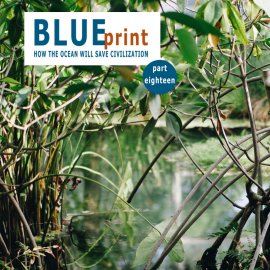Blue Bonds
-
English
-
ListenPause
[intro music] Welcome to World Ocean Radio… I’m Peter Neill, Director of the World Ocean Observatory. A bond is a fixed income instrument used by corporations, municipalities, states and governments to finance capital expenditures and operations that enroll multiple investors as lenders, rather than shareholders, and to guarantee return through predictable interest payments, and a maturity date for repayment of principal in full. Bonds can be traded, their market price can fluctuate, but they are considered more conservative as invulnerable to volatile interest rates and expectation of full and safe principal return. Pension funds, large endowments, and individual investors use a percentage of bonds in their portfolio as a safe harbor in the chaotic, disconnected motion of the financial markets. Bonds have historically been used to finance infrastructure, municipal construction projects, educational facilities, corporate expansion, and more, and have their own community of funds, brokers, traders, and stolid investors selling safety and balance. But as with all financial instruments, bonds can be used differently and creatively in our changing investment world wherein old premises and conventional approaches are morphing toward new opportunities. Bonds are emerging as an innovative tool for capital generation and support for new industries responding to the exigencies of climate change: alternative energy technology, fresh water, sanitation, desalination plants, coastal protections, and other inevitable and transformative enterprise that needs large influx of capital to make it so. The instrument remains much the same, but what it is used to finance is the welcome difference. The Nature Conservancy, an international conservation organization, has announced a “blue bond program,” something of a misnomer in that the program very much resembles “debt for nature swaps,” in the 1990s whereby international lenders would forgive outstanding, mostly unpayable debt, as long as the amounts forgiven would be invested by the debtor government in specific conservation goals, such as the designation of large undeveloped areas for nature preserves and recreational use which, in some impressive examples, converted dramatically to drive eco-tourism, create new employment, stabilize local governments, and provide resultant new economic vitality. The program was a powerful and positive contribution to both environmental protection and social improvement. The (TNC) program provides “an opportunity for island and coastal nations to reinvest in their natural resources by refinancing their national debt in a way that secures funding for a commitment to protect at least 30% of their near-shore ocean areas, including coral reefs, mangroves and other important habitats, and engage in ongoing conservation work such as improving fisheries management and reducing pollution.” The Nature Conservancy then “leverages public grants and commercial capital to restructure the nations’ sovereign debt, leading to lower interest rates and longer repayment periods.” TNC acts as a catalyst, bringing “together key players, including the World Bank, commercial investors, the coastal nation, and public funders to negotiate the debt-for-ocean deal.” While not a bond per se, the initiative serves a similar purpose to create, expand, and manage marine-protected areas, remarkable coastal and ocean biodiversity reserves, to generate and/or re-direct increased available capital, and to build a financial structure that is affordable, innovative, and rewarding as an equity asset and model for conservation finance worldwide. TNC argues that this system has an astonishing multiplier effect through savings, restored local communities, livelihoods, and cultural traditions, and the ecosystem service value of vast new areas in the Caribbean, the Pacific Islands, and the West Indian Ocean. TNC equates a $40 million investment in support of blue bonds, augmented by $200 million in grant funding and private investment to purchase nations’ debt that is further re-financed for payment to lenders and thereafter to ocean conservation action – from $40 million to $1.6 billion of consequential value, monetized and invested. If it works for one country, it is a success. TNC estimates that some 85 nations could benefit from this massive re-distribution of protected ocean resources, with added value to follow through fisheries management, ongoing eco-tourism, mitigation of climate factors, fair equity and social justice. A bond is more than a financial instrument: it is a connection that fastens things together. We are confronted today with aspects of disconnection and division between ourselves, our neighbors, our ideologies, our national interests, and our sense of possibility looking forward. How to connect? Where do we invest our assets, personal and otherwise, in a future that will sustain us? On what scale? And in what specific strategy for the highest return? It may be a portfolio purchase or a market trade. It may be an innovative debt restructure and conservation finance. It may be any opportunity in any direction in the sea that connects all things. The ocean is our bond. We will discuss these issues, and more, in future editions of World Ocean Radio. [outro music]
This week on World Ocean Radio: part eighteen of the multi-part BLUEprint series. In this episode we discuss the concept of blue bonds and a new Nature Conservancy program designed for small island and coastal nations to reinvest in their natural resources by refinancing national debt in a way that secures funding for a commitment to protect near-shore ocean areas such as coral reefs and mangroves.

The "BLUEprint Series: How the Ocean Will Save Civilization" outlines a new and sustainable path forward, with the ocean leading the way.
About World Ocean Radio
Since 2009, a weekly 5-minute podcast covering a broad spectrum of ocean issues from science and education to advocacy and exemplary projects. World Ocean Radio, a project of the World Ocean Observatory, is available for syndicated use at no cost by college and community radio stations worldwide. Contact director@thew2o.net if you are interested in becoming an affiliate or know of a radio station that should be broadcasting these episodes each week.
Image
Photo by Maxwell Ridgeway on Unsplash
- Login to post comments



